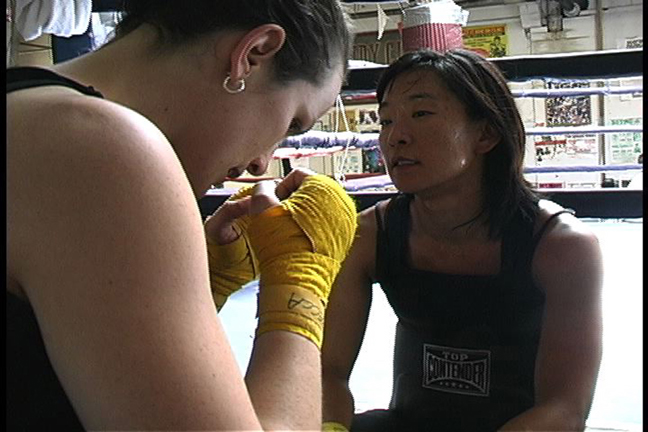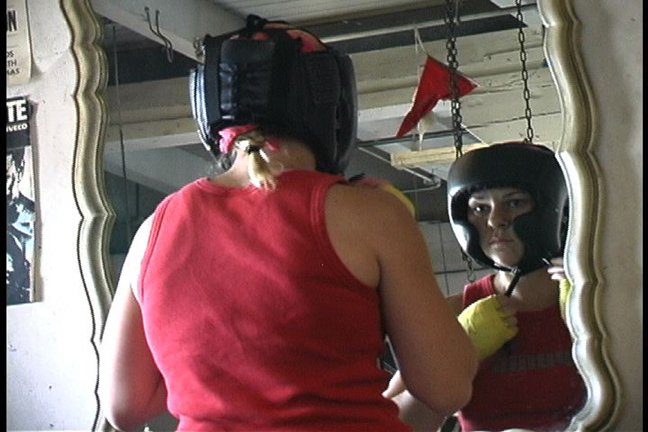Boxing Makes You Smart
Suzanne Szucs saw "The Boxers" (directed, written and produced by Joanna Kohler at the Women with Vision Film Festival) at the Uppercut Gym. It connected.




Power is something that is only available to you when you have discipline
Becca Gilgen, The Boxers
Boxing has long been one of the most engaging sports metaphors in our culture. Even Gen Y-ers know who Mohammed Ali is, although they might not know that his greatest battle was fought outside the ring. For Black men, boxing has been an arena where they forge physical and intellectual parity with their opponents. Through pummeling and being pummeled, they reverse the legacy of enforced commerce written through the color of skin, claiming power socially denied.
Following Martin Luther King’s call for Black men to resist the Vietnam War (to not have their bodies be used as war machines by a government that would not acknowledge their basic civil rights), Ali refused to enlist. As a result he was stripped of his boxing title and license – essentially his livelihood and his identity. Ali persisted, both within the ring and out, ironically becoming an icon for non-violent resistance.
The women of Joanna Kohler’s The Boxers also seek power within the ring. Although Lisa Bauch, the founder of Uppercut Gym, where the women train, speaks briefly in the film about taking up boxing to overcome fear, and although an undercurrent of bucking the establishment does exist in the film, the emphasis is not on oppression, but on discipline and insight gained through the sport. The women of the film are ambitious – not just to win in the ring, but to see how far they can push themselves. They are obsessed with the sport, proud of what they have achieved. They recognize that they seem like outsiders to others. They want to be identified as boxers first and foremost, but cannot get away from the fact that their accomplishment does stand out. Most women will never hit another person. Our society encourages a culture of fear in women; girls are taught that it is unladylike to fight. In an era where “feminism” has become a dirty word and Title IX is being challenged, these women are transcending cultural bias.
It is personal discipline (“Patience, frustration, anger, focus,” says Bauch) that drives the women represented in the film. Boxers Becca Gilgen, Amy Laboe, Sarah Mickelson, Rachel Schley, Dagney Willey, coach Gina Campbell and Bauch offer Kohler unqualified vulnerability in talking about their immediate goal of success at the Riverside International Tournament and the work they must do to achieve that.
What is particularly refreshing about the women is their candor – they know when they have done well, they evaluate themselves honestly, and they take responsibility for their own failures. “The gym” not only teaches them discipline, but also how to be their best selves. They understand they are doing this for themselves – a pursuit not always respected in a society where self-sacrifice and doing for others is expected from virtuous women.
Kohler’s cinematography emphasizes this personal pursuit. The camera favors shots featuring individual women demonstrating the art and meditation inherent in training. In preparing for the fights, we see the women dancing alone, practicing their hits against an invisible enemy. The viewer can’t help but read that dance as with the self, the inherent fear we all carry – am I good enough, will I fail, what will happen to me, will I suffer?
The fights themselves are short – this viewer (and the boxers) longed for more – and the difference between them and training is apparent. As Becca says in anticipation, “When you fight, when you’re done, something changes.” It’s the epic hero’s journey in 3-minute rounds – “When someone hits you in the face, you know yourself in that instant.”
That doesn’t mean that you know what the other individual is bringing into the ring. Like life, the boxing world is not fair. Competition requires judges and inequities abound. “You think, if you work hard enough, you’re gonna win,” muses Rachel, disappointed in the outcome of one of her fights. Faced with disappointment, the women do not play the victim card. Instead, they get back into the ring for more training. Kohler’s end shot, running through the credits, is of Gilgen solo training – an interior battle with her mirrored image.
Ultimately, the lesson is persistence. Ali used it as a fighting technique. But he knew his limits, how long he could take the hits. The Boxers is a story of transformation, and Kohler, very smartly, gets out of the way of her subjects. Deftly, she lets them tell the story and then, like the sport itself, renders it with precision, passion and art.
For the women here, the boxing metaphor is real. Body as a location of power in a culture that still values physical subservience in women makes these women subversive. Ironically, it is their individual vulnerability and their cohesiveness as a supportive group of friends outside of the ring that demonstrates their greatest strengths.